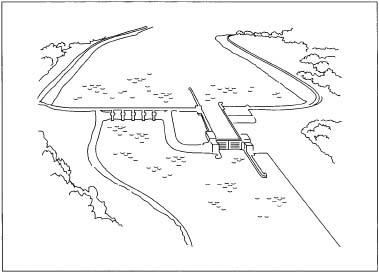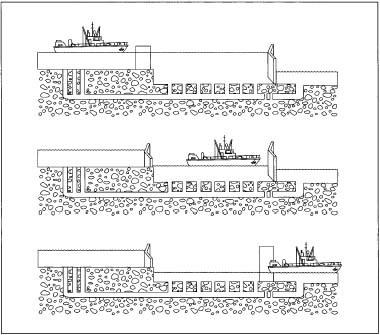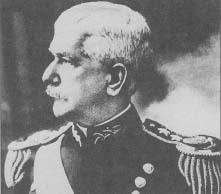Canal and Lock
Background
A canal is a man-made waterway. Canals are built for a variety of uses including irrigation, land drainage, urban water supply, hydroelectric power generation, and transportation of cargo and people. Navigation canals may be shallow facilities designed for barge traffic, or they may be deep enough to accommodate ocean-going ships.
To conserve water and to facilitate two-way travel, canals are built level. If there is a difference in elevation between the ends of a canal, the channel is built as a series of level sections linked by locks. A lock is a rectangular chamber with gates at both ends; with both gates closed, the water level within the lock can be adjusted to match the canal water level on either side. Thus, a vessel entering the lock can be raised or lowered in order to enter the next level canal section. Alternative types of locks are occasionally built to traverse large elevation changes; the entire lock chamber, containing boats floating on water, is hoisted vertically or moved up an inclined section of rail line.
In the United States, about 15% of the intercity freight (measured as a combination of distance and weight) is carried by water, on either artificial canals or navigable rivers. (Straightening or deepening a river to accommodate vessels of a certain desired size is called canalizing the waterway.) In 1997, 1.2 billion tons (1.1 billion metric tons) of cargo was transported on United States waterways; by 2020, the annual tonnage is expected to be twice that amount. Transportation of cargo by barge costs about half as much as moving it by rail and about one-eighth as trucking it.
The U.S. Army Corps of Engineers oversees some 25,000 mi (40,234 km) of commercially navigable waterways and about 240 lock chambers. Half of these locks are more than 50 years old, and some are too small for the large collections of barges that are commonly linked and moved by a single modern tugboat. With the expected increase in waterborne cargo transportation, it will be necessary to refurbish, replace, and enlarge many locks. Canal construction, which includes not only transportation waterways but also channels designed for environmental purposes, will also continue.
History
Canals
Reportedly, canals were built in Egypt as much as 6,000 years ago. The first canal designed to accommodate seaworthy ships was built by the Pharaoh Sesosteris I4,000 years ago, linking the Red Sea to the Nile River and thus to the Mediterranean Sea. Remnants of this canal, which was alternately neglected and rebuilt half a dozen times, suggest that it was about 150 ft (46 m) wide, 16 ft (5 m) deep, and 60 mi (97 km) long.
The oldest canal still in use was begun in China in the fourth century B.C. for the purposes of collecting grain taxes and transporting troops. Rebuilt and enlarged about A.D. 600, the channel became known as the Grand Canal; its latest extension, completed about A.D. 1280, brought its length to 1,114 mi (1,795 km). It remains the longest navigable canal in the world.
For centuries, canals were dug using only hand tools. While building the Canal du Midi between 1665 and 1681 to link the Atlantic

Locks
Flash locks, the first attempts to carry boats over difficult elevation changes on rivers or canals, date from the third century B.C. Greek historian Diodorus Siculus, writing 200 years later, described how Ptolemy II had improved the Nile-to-Red Sea canal by building a type of lock. Consisting of a single gate, flash locks carried boats downstream on a rush of water; boats headed upstream could be pulled forward while floating on the torrent released by opening the gate.
Flash locks were hazardous, and they used large amounts of water. A significant improvement came in A.D. 984, when the first double-gate lock was built on China's Grand Canal. Also called a pound lock (because it impounds water) this was the predecessor of modern conventional locks. Its gates were panels that lifted vertically. A similar lock with vertical-lift gates built in the Netherlands in 1373 also controlled its water level by partially opening either the upstream or the downstream gate. Pound lock operation was greatly improved in 1485 when an Italian lock was built with smaller, valve-controlled openings in the gates.
Leonardo da Vinci invented the miter gate in 1480. Two gates, each more than half as wide as the lock, swing on vertical hinges. In the open position, they are flush with the lock's walls. In the closed position, they meet in a V pointed upstream so that the higher water level presses against them to promote a tight seal.
The base of the upstream gate in a lock is higher than the base of the downstream gate. If the lock was very deep, water filling the chamber through an opening in the upper gate would create turbulence or even swamp a boat in the chamber. This problem was solved in France during the seventeenth century, when valve-controlled water channels for filling and emptying a lock were built

Until the early nineteenth century, lock gates were made of wood, and lock chambers were lined with wood, stone, bricks, or turf. In 1827, cast iron was first used to build both a lock and its gates in Cheshire, England. Following the development of the Bessemer process for mass production of steel, that material was utilized for construction of locks and gates, both as primary elements and as reinforcing bars for concrete.
Raw Materials
Waterproof linings keep a canal's water from seeping into the ground. For many years, the best choice was puddle, a mixture of sand, clay, and water that dried to a waterproof state. Modern materials and additives that are more durable include concrete, fly ash, bentonite, bituminous materials, and plastic sheeting.
Locks are usually made of concrete, occasionally lined with steel. If construction of the lock exposes bedrock, the floor need not be lined. The gates are made by welding together steel plates and reinforcement beams. The vertical edges of the gates are fitted with effective sealing materials such as white oak. In 1999, a French company developed lock gates made of glass-fiber reinforced plastic laminate mounted in stainless steel frames.
Design
Early canals followed the most level surface route possible because large-scale earth-moving was so difficult and expensive. Better excavation equipment and lock construction capabilities permit the construction of shorter, more direct canal routes. Because of geographic obstacles, sections of some canals are built in tunnels or on aqueducts (water-carrying bridges).
It is important to fill and empty a lock chamber while producing minimal water turbulence. Modern designs place sluices in the gate sills or in the chamber's floor or walls. A lock may also be equipped with a submerged bubbler that releases air below the gate closure area; the resulting gentle turbulence keeps the area clear of debris that might prevent the gate from sealing properly.
Various gate designs are available for modern locks, and different types may be used on the upstream and downstream ends of a single lock. Miter gates are one of the most popular choices. Another common choice is the Tainter gate, a curved plate that rotates vertically. In this efficient design, which is used for valves in water-transfer culverts as well as main lock gates, water pressure actually assists in the gate's rotation. Flat gates that slide up, sideways, or down into the lock floor are other options, as are flat gates that are hinged at the bottom and curved gates that rotate horizontally into wall recesses.

William C. Gorgas was born October 3, 1854, near Mobile, Alabama. In 1875 Gorgas received a bachelor of arts degree from the University of the South. Desiring a military career he decided to enter the Army with a medical degree. After graduating from Bellevue Medical College in New York and interning at Bellevue Hospital, Gorgas was appointed to the Medical Corps of the U.S. Army in June 1880. Tours of duty followed in Texas and North Dakota, with nearly 10 years at Fort Barrancas in Florida—Gorgas was assigned this yellow fever area because he had previously had the disease and was immune.
After Havana, Cuba, was occupied by American troops in 1898, Gorgas took charge of a yellow fever camp at Siboney, soon becoming chief sanitary officer of Havana. Acting on information that a certain mosquito carried yellow fever, Gorgas quickly destroyed that mosquito's breeding ground, ridding the city of yellow fever.
In 1904, work commenced on the Panama Canal. Gorgas went to the Canal Zone to take charge of sanitation, succeeding in Panama and Colon. Gorgas came to be generally regarded as the world's foremost sanitary expert, and a number of foreign governments and international commissions sought his aid. His book Sanitation in Panama quickly became a classic in the public health field. In 1914 he was appointed surgeon general of the Army, serving in that capacity until his retirement four years later. Gorgas died on July 3, 1920, and is buried in Arlington National Cemetery.
The Manufacturing Process
Canal
- 1 A thorough survey of the canal route must be made, not only for correct alignment but also for accurate depths of cuts and fills.
- 2 Primary excavation is done with earth-moving equipment like bulldozers and excavators.
- 3 A crawler-track mounted trimming machine is used to remove the final 12-18 in (30-46 cm) of soil to create the desired wall slopes and flat bed for the canal. Excavated soil is carried by conveyor and loaded onto trucks that will haul it away.
- 4 A layer of highly permeable material may be spread over the walls and floor to promote drainage of groundwater under the canal.
- 5 Grids of reinforcing steel are built and l1ifted into place on the canal walls and floor. Concrete blocks hold the grids above the surface so concrete can flow under them.
- 6 Concrete is mixed, vibrated to remove air pockets, and applied with a slipform machine, encasing the reinforcing steel. Slipforming means pouring concrete between the canal surface and a form (mold) that slowly moves forward; the concrete hardens quickly enough to retain its shape by the time the form moves out of contact with it. Specialized machines place transverse and longitudinal expansion joints in advance of the slipform machine.
Lock
- 7 A temporary cofferdam is built around the proposed lock site. Steel sheet piles are driven into the ground to form a series of adjacent, vertical cells that extend above the waterline. The cells are filled with sand. Water is pumped out of the enclosed space to create a dry construction area. The lock site is excavated. If necessary, piles are driven into the ground to support the lock structure.
- 8 Wooden forms are built to shape the floor and walls of the lock. Space for culverts and valve chambers is included within the forms, as are slots for the gate hinges and recesses to contain open gates. Additional forms are built to shape the approach walls that will guide vessels into the lock.
- 9 After reinforcing steel cages are constructed in the forms, concrete is poured. When the concrete has cured (hardened), the forms are removed.
- 10 Control valves for filling and emptying the lock are installed, along with hydraulic and mechanical equipment for operating the valves and gates.
- 11 Gates are prefabricated and shipped to the site. Very large gates may be shipped in sections, which are welded together as they are installed in the lock.
- 12 Accessories such as guardrails, mooring posts, and escape ladders are installed on the lock walls.
Byproducts/Waste
Disposing of the excavated material is one of the challenges of canal and lock construction. It may be used to construct embankments or be spread over the surrounding countryside where it is carefully landscaped for erosion control as well as appearance. Construction of the Divide Cut, a 29-mi (46-km) canal on the Tennessee-Tombigbee Waterway, in the early 1980s required the disposal of 150 million cubic yards (115 million cubic meters) of dirt.
During lock construction, excavated material can be used to fill cofferdam cells. When the cofferdam is removed, the material may be used to fill in behind the riverbank side of the lock wall.
Lock operation uses large amounts of water; for example, it takes 3.5 million gal (13 million L) of water to fill a 600-ft (180-m) long, 110-ft (34-m) wide lock with a 7-ft (2.1-nm) lift. On some canals and rivers, water supplies are limited and conservation is important. Rather than being released downstream as the lock is emptied, some of the water may be diverted to a side pond, where it can be stored and used to help fill the chamber for its next operation.
The Future
Because of the significant need to recondition or replace locks as well as build new facilities, the U.S. Army Corps of Engineers sponsors and conducts research on water-way construction. Scale models of proposed designs can be tested at its Waterways Experiment Station. Through its Innovations for Navigation Projects (INP) Research Program, it supports the development of new ways to build, repair, and operate canals and locks. Recent topics included improvements in underwater concrete and grout placement and development of low-density, high-strength concrete for building modular lock sections that can be installed without construction of a cofferdam. Other current research topics involve protection devices for lock walls and gates from barge impacts, improved designs for water intake and discharge systems, better equipment and control devices for operating gates, and techniques for enlarging (rather than replacing) existing locks that have inadequate capacity.
Where to Learn More
Periodicals
"Pakistan Project Requires World's Largest Canal Machines." Engineering News-Record Magazine (December 20, 1999): B-3.
Other
"The ABC's of Lock Building." Trent-Sevem Waterway. http://collections.ic.gc.ca/waterway/rg_eng_i/abc.htm (May 16, 2000).
"Canal Machinery." Guntert and Zimmerman. http://www.guntert.com/Canal/Canal.htm (May 26, 2000).
International Canal Monuments. http://www.icomos.org (May 17, 2000).
"Lock Construction Project." U.S. Army Corps of Engineers. http://www.lrl.usace.army.mil/olmsted/cd-pics/960517ad.htm (May 26, 2000).
Tennessee Tombigbee Waterway. http://www.tenntom.org (May 10, 2000).
— Loretta Hall